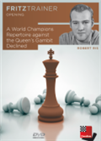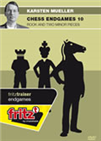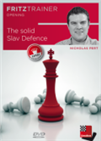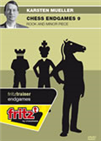Topalov leads at the half-way mark
Even after four rounds, the Vugar Gashimov Memorial had not really gotten going; 19 of the 20 games ended in draws. The single game that found a winner was Veselin Topalov's defeat of Shakhriyar Mamedyarov in the fourth round. Now, two more wins give the impression that the tournament seems to be gaining pace.
Tuesday is the rest day, so Magnus Carlsen will have plenty of time to mull over his upcoming white game against Topalov in round seven. But first he'll have to get by his former challenger Sergey Karjakin with the black pieces on Wednesday.

Carlsen-Wojtaszek
In Monday's fifth round, Carlsen finally scored his first victory in the tournament. His opening can perhaps be understood as an homage to Vugar Gashimov:
Gashimov played this original move a total of nine times from 2006 to 2009 and won six of these games. However, after 3...cxd4 4.Qxd4 Nc6 the Azeri top grandmaster continued with 5.Bb5. Carlsen chose the odd-looking queen retreat 5.Qd2 instead and then fianchettoed his bishop to b2 — creative! This approach is not entirely new, but the few predecessor games were all between beginner or amateur players. Does the World Champion play like a beginner? Hardly! First appearances can be deceptive, of course, because in fact, the Norwegian had in mind an interesting deployment plan.
A few moves later, it looked like this:
An almost normal Sicilian, but the Ng1 did not move to d4, but to g5 (better?).
Wojtaszek kept the game in balance for a long time and got a couple of extra chances from the World Champion, but finally, the Polish grandmaster's luck ran out:
Black's last rook move was a mistake. Carlsen quickly swapped rooks and played 28.Rh2, attacking the bishop and threatening mate in three.
Ding Liren played in constricting style in a Bf4 variation of the Queen's Gambit declined against Teimour Radjabov.
 This DVD offers a complete repertoire for handling this solid opening, often featuring a dynamic approach to pose the opponent more practical problems. Both of the main continuations 3...Nf6 and 3...Be7 are covered in two separate parts.
This DVD offers a complete repertoire for handling this solid opening, often featuring a dynamic approach to pose the opponent more practical problems. Both of the main continuations 3...Nf6 and 3...Be7 are covered in two separate parts.
Here White played the rare 14.Qe2, whereas 14.Bxa6 is most common. Gradually, Black freed himself on the queenside and then even had easier play. A simplification combination eventually resulted in an even endgame with a rook, minor piece and pawns, and a draw soon followed on the 40th move.
 Although the distribution of material with a rook and two minor pieces against a rook and two minor pieces is a very common one in practical play, there is very little literature on the subject apart from that dealing with questions relating to the bishop pair.
Although the distribution of material with a rook and two minor pieces against a rook and two minor pieces is a very common one in practical play, there is very little literature on the subject apart from that dealing with questions relating to the bishop pair.There was also the same Bf4 variation (maybe one should call it the "Blackburne variation?") in the game between Shakhriyar Mamedyarov and Anish Giri. This time, however White refrained from the space grabbing c4-c5, and Black took the opportunity to do so himself. The players followed the game Vachier Lagrave-Adams, from the 2012 Istanbul Olympiad through 18 moves, until Mamedyarov deviated with 19.Qd3. After a queen exchange, a balanced endgame with a rook and minor pieces and a symmetrical pawn structure ensued, in which neither side could make inroads.
Against Rauf Mamedov, Sergey Karjakin chose the Sicilian defence and then had to deal with 3.Bb5. Karjakin opted for 3...Bd7 and you can also find many predecessors through move 16.
After a few tactical skirmishes, the suspense dissolved in the endgame to a draw.
Scoring his second victory in the tournament was Veselin Topalov, who won Monday with black against David Navara.

Taopalov und Navara
 This Slav DVD is a complete opening repertoire for black after 1.d4 d5 2.c4 c6. GM Nick Pert has played the Slav defence for over 10 years and provides all his latest and most up to date analysis crammed into one video series. Nick has spent many hours studying the best Slav lines, and he explains his favourite variations, plus includes some interactive clips where the viewer is tested on a range of theoretical questions and tactics arising from Slav games.
This Slav DVD is a complete opening repertoire for black after 1.d4 d5 2.c4 c6. GM Nick Pert has played the Slav defence for over 10 years and provides all his latest and most up to date analysis crammed into one video series. Nick has spent many hours studying the best Slav lines, and he explains his favourite variations, plus includes some interactive clips where the viewer is tested on a range of theoretical questions and tactics arising from Slav games.Topalov gained the bishop pair in the middle game, which became a strong asset after both pairs of rooks and the queens were exchanged.
 Endings with rook and minor piece against rook and minor piece occur very frequently, even more often than rook endings, yet there's not much literature on them. This endgame DVD fills this gap. The four different material constellations rook and knight vs rook and knight, rooks and opposite coloured (and same coloured ) bishops and rook and bishop vs rook and knight are dealt with. In view of the different material constellations Karsten Mueller explains many guidelines like e.g. "With knights even a small initiative weighs heavily".
Endings with rook and minor piece against rook and minor piece occur very frequently, even more often than rook endings, yet there's not much literature on them. This endgame DVD fills this gap. The four different material constellations rook and knight vs rook and knight, rooks and opposite coloured (and same coloured ) bishops and rook and bishop vs rook and knight are dealt with. In view of the different material constellations Karsten Mueller explains many guidelines like e.g. "With knights even a small initiative weighs heavily".Navara's a5 pawn is weak and after the decisive mistake 44.Nd2? it drops off. 44...Bb4 45.Bb3 Bxb3 46.Nxb3 c5 with c4 to follow. With two connected pawns on the queenside, a win for the Bulgarian was no longer in doubt.
Standings after five rounds
All games of round five
Links
























